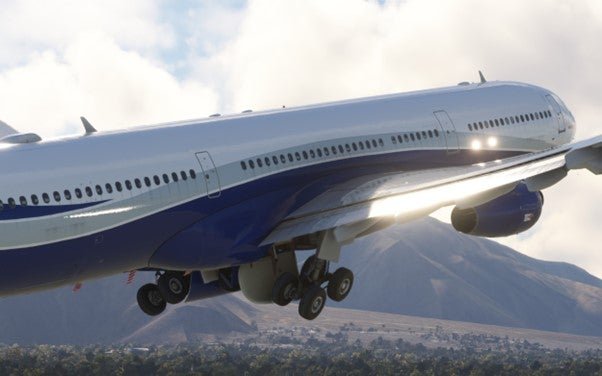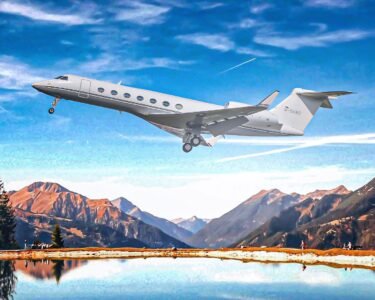Ever since I was in my 20s, when flight simulation started incorporating airliners capable of flying massive distances, uninterrupted on autopilot, with little risk of disaster, I felt safe taking round-the-world trips.
I remember buying sets of highly decorated various airliners with probably just 2D cockpits. We could get everything back then in the mid 1990s, when airlines around the world were still flying everything from 727s and DC-8s to 747 Classics.
I remember dying to fly the Hong Kong International Airport (VHHH) checkerboard approach with world scenery starting to appear all over, but I refused to break the “flight simmers code of conduct” set forth by none other than myself. This code followed one command: In order to fly to some distant part of the globe, you must fly there in real time on a “real” flight.
Selecting a menu or instant positioning to any airport was strictly against the code. I would cringe at all my fellow flight simmer friends who just subscribed to a “go-there-because-I-can” type of mentality. My attempts at encouraging them to punish themselves for their acts went mostly ignored.
The first amendment of the primary code is that you can only be in one part of the globe at any one time. If you took 14 hours to fly to Hong Kong, then you’re not able to join a friend in Florida to fly in formation on the same day. Forget about it. This harsh way of enjoying the hobby is the only way to go.
To conduct these long flights today, we finally have a sim that does it without issue. It used to be that Microsoft Flight Simulator (MSFS) would slow down in performance over time, often reaching half of its normal performance at takeoff. To finally make it halfway around the world, often flying overnight to a horrible, jerky, stutter-filled mess was a real killjoy. But now with the more powerful machinery and a far advanced and updated MSFS over the last year, we can enjoy a 14-plus-hour trip with our computer keeping up just fine.
There are some great new add-on aircraft available to make these journeys both realistic and reliable. Most recently I purchased the great new quad-jet A340-300 from the in-sim marketplace developed by LatinVFR. While not advertised as a “study level” airliner, it is a real beautiful, solid, and realistic rendition of one of my favorite heavy jets. It also has the complete passenger cabin modeled, which I am in favor of.
Being able to “walk” around the interior to stretch your legs or take in the view from numerous hotkeys is a great feature we are seeing from many more big jet manufacturers in MSFS. It really adds to the immersion factor to be able to do this.

Flying over Mount Rainier as I test out flight quality during a short mission. [Courtesy: Peter James]

First-class wing view. I have views saved in first class and coach, both left and right sides. ‘MSFS’ allows only nine preset hotkey views, so you must be choosy in picking them. [Courtesy: Peter James]

The A340’s massive interior is modeled well and easy to ‘walk’ around in. [Courtesy: Peter James]

Private charter HiFly liveried A340 over Rainier, as I evaluate the quality of this recently released product and see if she is suitable for the long haul. [Courtesy: Peter James]
After testing the A340 for a few short flights I have concluded she’s a good solid addition to my fleet. I ended up at Ted Stevens Anchorage International Airport (PANC).
However, some errors or incomplete items exist in the flight management system (FMS) programming, affecting autopilot functionality in general. There are some bugs with auto throttle and airbus logic as well. So consider this a fun, stable, nice hand-flying beast with the well-known A340 sluggishness it’s famous for.
Four small CFM A320 engines slung under the huge airframe is certainly odd, although I love the look. It’s graceful and sleek, and the big titling gear makes for some incredible butter-smooth touchdowns that almost anyone can perform.
The sound set provided is nicely done, with a great harmonic hum being heard at takeoff and during climb power, similar to exactly what you hear on a CFM-modeled A320, which makes sense as that is basically what is propelling the monster. The 340 takes some time to get used to and has its quirks and flying quality habits, but that is part of the fun as it represents what the real jet feels like in a good way.

BravoAirspace designers’ newly released 787-8 is a real treat to fly and operate. Fully functional cockpit based on the Asobo default 787-10 (premium edition ‘MSFS’ must be owned and installed for this to work) is available from the in-store marketplace as well, right within the ‘MSFS’ interface. [Courtesy: Peter James]
The BravoAirspace sim company released its newest offering—a 787—in May. In order to try out the new 787-8, I first ran a series of tests around PANC. It was a real joy to fly, just as good as any 787 I have used in the sim.
All the 787s available, including the default Asobo-stretched 787-10, are very well modeled now and have pretty complete simulations with FMS and other systems. However, this one features an entirely modeled cabin that is the best one I have seen to date of any sim jet. It’s second to flight modeling, and this one flies well. It is rock solid on autopilot, stable on autoland, and wonderful to hand-fly.
The FMS programming, along with a built-in flight pad of sorts, helps speed and performance programming. All the parts externally are executed perfectly in scale and placement. My only gripe is that the designer chose to go with the worn-out dirty look, rather than a newer or cleaner appearance. I like both options. Hopefully, someone will soon upload a brand-new clean paint for me to enjoy too.

This workhorse is showing a little grime as she never stops crisscrossing the globe. [Courtesy: Peter James]
The real thrill of long-distance globe hopping to me is seeing the new scenery the world provides along with local immersion factors, such as structure styles, foliage types, road traffic, and potentially new weather special to that area. I also love that I am storing away all this visual and local airport knowledge in my head, so that someday if I ever end up in these faraway places, I may feel like it’s déjà vu. Once arriving into faraway locations in heavy jets, I’ll grab a smaller GA plane to really see the local area, backcountry strips, or coastal resorts accessible by floatplane only.

The plush first-class cabin is nicely done with curtains and custom seat back display screens that change with the livery. [Courtesy: Peter James]
Some sim pilots only care about the flight deck in detail, without any concern for the cabin to be modeled at all. I am a firm lover of all the immersion we can have, and if the cabin is modeled well without any hit on PC performance, then let’s have it. I love placing passenger views. It’s fun to “walk” around the cabin at random times just taking it all in, making it complete.

As night falls, the mood lightning adjusts. [Courtesy: Peter James]
The BravoAirspace 787 add-on really boasts the best airliner cabin I have ever seen in MSFS. The plush curtains and individual seat back video screens that are custom to the airline livery are a great visual. And the mood lighting that many new airliners have now is modeled to change with the time of day simulated.

Evening trip on the way to Sapporo, Japan, from Alaska in about six hours or less. The 788 cruises fast at Mach 0.87. [Courtesy: Peter James]

Love this mood lighting. The best effect I have seen in any sim during a night flight. [Courtesy: Peter James]

Turning final for RJCC at Sapporo Japan, you can see this model spitting out drag moisture in the tropical air of a damp twilight. The model knows when to add this effect to engine inlets, wings, and drag surfaces. [Courtesy: Peter James]
I was excited to suddenly see the vapor trails and fogging being modeled on engine compression on takeoff, wings, and drag surfaces. This is based on moisture simulated at the time, and Asia was moist. Landing in the predawn hours, seeing it all from a passenger window, was super. The fogging was well done, intermittent and seemingly based on control movements, pitch and power, just like real life as far as I know, including my only experience as a passenger on a Dreamliner near the wing a couple of years ago.

Wing and speedbrake fogging effect that occurs naturally at the right times. [Courtesy: Peter James]

Mood lighting example in the early evening. [Courtesy: Peter James]

Mood lighting example by just advancing the clock to late night. [Courtesy: Peter James]

Accurate 787 LED pulse lighting is evident and well done. The visuals are well designed, and the lighting is especially brilliant and bright, something a few jets lack on design. [Courtesy: Peter James]

Final leg of this journey to Kuala Lumpur, Malaysia, on ANA, avoiding some heaping tropical boil-ups, very typical of the region and well modeled on live weather. [Courtesy: Peter James]

ANA cabin customization eye candy adding to the realism. [Courtesy: Peter James]
After the long leg to Malaysia, I next flew the one and only Boeing Business Jet (BBJ) to other Pacific Islands to the east, such as Palau, where they once filmed Survivor TV episodes.

The famous PMDG 737NG series shown in BBJ model—a small but exceptionally modeled long hauler. [Courtesy: Peter James]
I love the PMDG BBJ model. It’s easy to get up and running, perfectly modeled visually, and a ton of fun to hand-fly. I see many BBJs everywhere I go in real life, as they are the epitome of a private jet. Certainly larger than any bizjet built specifically for that purpose, it towers over most on any GA ramp, yet can easily operate to and from at a 4,500-by-100-foot runway.
BBJs come with “short field options” added to the stock 737-700 base unit, allowing slower takeoff and landing speeds and additional flap degrees for departure. It’s all included in the many options found within the PMDG FMS unit in the virtual cockpit. With all the details maximized, it’s a treat to see zero performance decrease on a PC, when compared to a default Cessna.

Luxurious and large, a flying house awaits the virtual passenger. The entire cabin is fully modeled as well. [Courtesy: Peter James]

Beautifully clean and waxed, she shows off after landing in the South Pacific. Many PMDG BBJs have individual liveries and somewhat variable window configuration as in real life. The tropical vegetation is stock with many locations as well as unique local buildings, roofs, and other details that look ‘Pacific island like.’ [Courtesy: Peter James]

Using Navigraph on board is a treat as well. [Courtesy: Peter James]
I recently subscribed to Navigraph and have been slowly learning how to use it. I am still a complete novice but have figured out how to get it showing on the EFB in the PMDG BBJ.

Stunning view over the South Pacific areas of the globe. [Courtesy: Peter James]
Once breaking clouds over Palau, I was stunned at the mirror imagery as the cumulus fully reflected off the blue waters below. With calm winds, nothing but a mirror lay below, matching the sky condition and reflecting the image above and below the horizon, a very odd yet realistic vertigo challenge.
I am so excited you could honestly practice vertigo awareness in MSFS. It is another reason manually setting weather is so pleasing in the system, as you can really produce great visuals and “skyscapes” that can make colors and details pop.

Vertigo-inducing VFR day weather with awesome reflectivity from calm waters. [Courtesy: Peter James]



